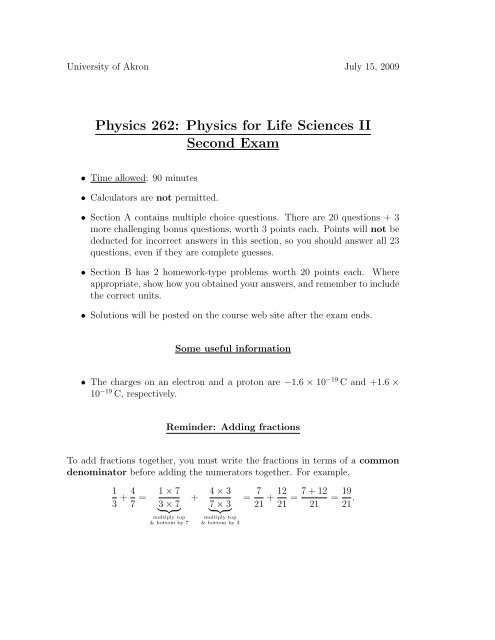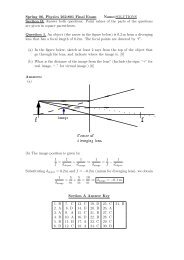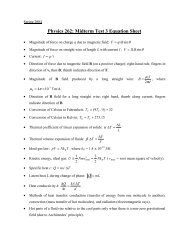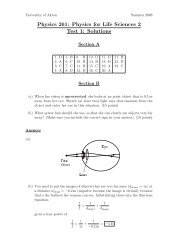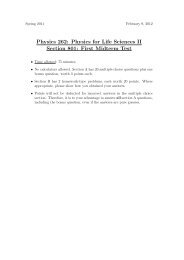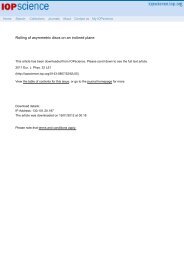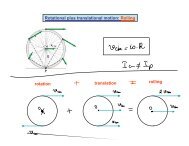Physics 262 Physics for Life Sciences II Second Exam
Exam 2 (PDF) - Physics
Exam 2 (PDF) - Physics
- No tags were found...
Create successful ePaper yourself
Turn your PDF publications into a flip-book with our unique Google optimized e-Paper software.
University of Akron July 15, 2009<strong>Physics</strong> <strong>262</strong>: <strong>Physics</strong> <strong>for</strong> <strong>Life</strong> <strong>Sciences</strong> <strong>II</strong><strong>Second</strong> <strong>Exam</strong>• Time allowed: 90 minutes• Calculators are not permitted.• Section A contains multiple choice questions. There are 20 questions + 3more challenging bonus questions, worth 3 points each. Points will not bededucted <strong>for</strong> incorrect answers in this section, so you should answer all 23questions, even if they are complete guesses.• Section B has 2 homework-type problems worth 20 points each. Whereappropriate, show how you obtained your answers, and remember to includethe correct units.• Solutions will be posted on the course web site after the exam ends.Some useful in<strong>for</strong>mation• The charges on an electron and a proton are −1.6 × 10 −19 C and +1.6 ×10 −19 C, respectively.Reminder: Adding fractionsTo add fractions together, you must write the fractions in terms of a commondenominator be<strong>for</strong>e adding the numerators together. For example,13 + 4 7 = 1 × 7 + 4 × 3}3{{× 7} }7{{× 3}= 721 + 1221 = 7 + 1221multiply top& bottom by 7multiply top& bottom by 3= 1921 .
SECTION A1. An ionized flourine atom containing 7 protons and 8 electrons has a netcharge of(A) +1.0 C (B) −1.0 C (C) +1.6 × 10 −19 C (D) −1.6 × 10 −19 C2. I bring a negatively charged rod near (butnot touching) the bulb of an initially electricallyneutral electroscope, so that the pointerof the electroscope rises (Step 1). Keepingthe rod near the bulb, I then ground the electroscopeby touching the bulb, which resultsin the pointer falling (Step 2). In step 2,which of the following is true about the netcharges on the bulb and the pointer of theelectroscope?(A) Both the bulb and pointer have net positive charge.(B) The bulb has net positive charge and the pointer is electrically neutral.(C) The bulb is electrically neutral and the pointer has net positive charge.(D) Both the bulb and the pointer are electrically neutral.3. A square object has a charge of −2 × 10 −9 C and a round object has acharge of +1 × 10 −9 C. They are placed close to each other. Which of thefollowing figures best indicates the directions and magnitudes (indicated bythe length of the vectors) of the electric <strong>for</strong>ces of the objects on one another?4. The magnitude of the Coulomb (i.e., electric) <strong>for</strong>ce between two pointcharges is F when they are separated by a distance d. The separationis changed so that the magnitude of the Coulomb <strong>for</strong>ce between them is2F . What is the new separation between the charges?(A) d d(B) √ (C) √ 2 d (D) 2d225. In a region of space, the electric potential is constant at 100 V. What is themagnitude of the <strong>for</strong>ce on a charge of 5 C in that region of space?(A) 500 N (B) 100 N (C) 20 N (D) 0 N
6. If there are more electric field lines going into than coming out of a Guassian(i.e., an imaginary closed) surface, this means that(A) there cannot be any positive charges enclosed by the Gaussian surface.(B) there more negative than positive charges enclosed by the Gaussiansurface.(C) there are more positive than negative charges enclosed by the Gaussiansurface.(D) there cannot be any negative charges enclosed by the Gaussian surface.7. An electron is subjected to an electric <strong>for</strong>ce of 1.6×10 −15 N in the downwarddirection. The electric field at the position of the electron is(A) (1.6) 2 × 10 −34 V/m, pointing upwards.(B) 1.0 × 10 4 V/m, pointing upwards.(C) (1.6) 2 × 10 −34 V/m, pointing downwards.(D) 1.0 × 10 4 V/m, pointing downwards.8. The figure below shows a charge dipole (an object with a positive chargeat one end and an equal magnitude of negative charge at the other) in aregion with electric field lines that are parallel and equally spaced fromeach other. The positive and negative charges are indicated by “+” and“-”, respectively. In which direction is the net <strong>for</strong>ce of the electric field onthe dipole?(A) ← (B) → (C) ↗ (D) No net <strong>for</strong>ce9. A 1 mF (1 × 10 −3 F) and a 2 mF (2 × 10 −3 F) capacitor are connected inparallel to a 6 V battery, as shown below. What is the total charge storedin the two capacitors?(A) 4 × 10 −3 C (B) 1.8 × 10 −2 C (C) 2 × 10 3 C (D) 9 × 10 3 C
The following pertains to questions 10 and 11. The following diagram showsequipotential surfaces in a region of space. A charge of −2 C is moved fromposition A to B (indicated by the dots).10. What is the change in the electric potential when moving from A to B?(Remember, “change in” means final value minus initial value.)(A) −80 V (B) −40 V (C) 40 V (D) 80 V11. What is the change in the electric potential energy of the −2 C charge whenit is moved from A to B?(A) −80 J (B) −40 J (C) 40 J (D) 80 JThe following pertains to questions 12 and 13. The following diagram showsequipotential surfaces in a region of space. (Assume the electric field variessmoothly in this region.)12. In what direction is the electric field pointing in this region of space?(A) ← (B) → (C) ↑ (D) ↓13. At which of the marked positions A – D is the magnitude of the electricfield the smallest?14. Three resistors that have values of 5 Ω, 2 Ω and 1 Ω are connected in seriesto a battery. Which resistor gets the most power?(A) 5 Ω (B) 2 Ω (C) 1 Ω (D) Same in all three.15. Three resistors that have values of 5 Ω, 2 Ω and 1 Ω are connected in parallelto a battery. Which resistor gets the most power?(A) 5 Ω (B) 2 Ω (C) 1 Ω (D) Same in all three.
The following pertainsto questions 16 and17. A battery withEMF of 12 V and aninternal resistance of1 Ω is connected to a5 Ω resistor, as shownon the right. The negativeend of the batteryis at zero volts.16. What is the current through the circuit?(A) 2 A (B) 2.4 A (C) 10 A (D) 14.2 A17. What is the electric potential at point A?(A) 6 V (B) 10 V (C) 11 V (D) 12 V18. When a capacitor discharges through a resistor, the magnitude of currentthrough the resistor is maximum(A) at the beginning of the process.(B) at the middle of the process.(C) at the end of the process.(D) after one RC time constant.19. What, if anything, is wrong (in terms of safety) with the wiring of theelements of a household electric heater shown below?(A) The fuse is on the wrong side of the heating element.(B) The switch is on the wrong side of the heating element.(C) Both fuse and switch are on wrong sides of the heating element.(D) There is nothing wrong.
20. In the nation of Lowvoltagestan, household electricity has an RMS voltageof 60 V, compared to 120 V in the U.S. If a U.S. hairdryer that is ratedat 500 W is plugged into a Lowvoltagestan outlet, what power is consumedby the hairdryer (assuming it still works and its resistance is the same asin the U.S.)?(A) 125 W (B) 250 W (C) 1000 W (D) 2000 W21. Bonus 1: Two 2-mF capacitors, consisting of metallic plates with air (whichhas a dielectric constant of 1) in between the plates, are connected in series.If material with dielectric constant 2 is subsequently inserted in (andcompletely fills the space) between the plates of one of these capacitors,what is the equivalent capacitance these two capacitors in series?(A) 1 mF (B) 4 mF (C) 4 mF (D) 6 mF322. Bonus 2: In the following circuit, the electromotive <strong>for</strong>ce of the batteryand R 2 are unknown. What is the resistance R 1 ? (Hint: Use Kirchhoff’scurrent and voltage theorems.)(A) 1 Ω (B) 2 Ω (C) 6 Ω (D) 10Ω23. Bonus 3: Which of light bulbs A – D will not light up?
<strong>Physics</strong> <strong>262</strong>, Sum. ’09, <strong>Exam</strong> 2, section BName:Question 1: A +4 × 10 −9 C point charge is at x = 2 m and a −1 × 10 −9 Cpoint charge is at x = −3 m. What is the electric field at x = 0 m due to thesetwo charges? (Include the correct sign in your answer; i.e., “+” and “−” <strong>for</strong> theelectric field pointing in the positive and negative x-directions, respectively.)
Questions 2: You have 3 resistors of resistances 1 Ω, 1 2 Ω and 1 4 Ω.(a) What is the equivalent resistance when you connect all three resistors isseries? [8 points](b) What is the equivalent resistance when you connect all three resistors inparallel? [12 points]


